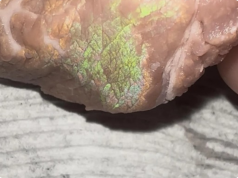Picture this: You’re exploring your grandparents’ attic, sifting through dusty photo albums, forgotten trinkets, and relics of a bygone era. Then, tucked in a drawer or nestled in a sewing basket, you find it — a smooth, egg-shaped object, cool to the touch, slightly heavy, and utterly mysterious.
It fits perfectly in your palm, polished by time, but its purpose? A complete enigma.
This exact moment played out for a Reddit user who recently posted a photo of such an object, captioned with the universal cry of the curious:
“Found this in my grandparents’ house. What is it?”
What followed was a delightful digital detective story — a blend of nostalgia, generational knowledge, and internet sleuthing — that led to a surprisingly charming answer:
It’s a darning egg.
Wait — What’s a Darning Egg?
If you’ve never heard of a darning egg, you’re not alone. In today’s world of fast fashion and disposable clothing, the art of darning — the practice of repairing holes in fabric, especially socks — has largely faded into obscurity.
But back in the day, a darning egg was a household essential, especially in homes where waste was unthinkable and every garment was cherished.
What It Does:
A darning egg is a small, solid, egg-shaped tool — traditionally made of wood, porcelain, glass, or marble — used to repair holes in knitted fabric, particularly socks.
Here’s how it worked:
- Insert the darning egg into the sock, beneath the hole.
- Stretch the fabric taut over its smooth surface — just like a tiny drum.
- Use a needle and thread to weave a patch over the hole, creating a tight, durable repair.
Without the darning egg, the sock would sag and bunch, making stitching nearly impossible. With it? A smooth, stable base for precision mending.
Why “Egg”? And Why So Many Materials?
The egg shape isn’t just whimsical — it’s functional. It mimics the curve of a foot, allowing the sock to stretch naturally and evenly. Plus, its compact size makes it easy to grip and maneuver.
As for materials:
- Wood — Lightweight, smooth, and easy to carve.
- Porcelain — Durable and often beautifully decorated.
- Glass or marble — Heavier, which helps keep the sock steady during sewing.
- Rubber or metal — Less common, but used in later models.
Some darning eggs were even shaped like mushrooms or adorned with hand-painted designs, turning a humble tool into a small work of art.
The Grandparents’ Nonchalant Revelation
When the Reddit user asked their grandparents about the mysterious object, they were met with a shrug and a simple:
“Oh, that’s just a paperweight.”
But the internet had other ideas.
Almost immediately, commenters — especially those with sewing experience or family ties to the pre-fast-fashion era — chimed in:
“That’s a darning egg!”
“My grandma had one just like it — she saved dozens of socks!”
“It’s like a Pokémon for seamstresses — rare, but legendary.”
The debate sparked a wave of nostalgia, with users sharing stories of grandmothers who could “resurrect” a sock with a few deft stitches and the help of their trusty darning egg.
Why We’ve Forgotten This Tiny Hero
The decline of the darning egg mirrors a broader cultural shift:
- Clothing became cheaper — why mend a sock when you can buy five new ones for $10?
- Synthetic fabrics — harder to darn and less durable.
- Time became more valuable — darning is slow, meticulous work.
But as sustainability grows in importance, the art of mending is making a quiet comeback.
Modern “visible mending” has even become a fashion statement, with colorful embroidery turning repairs into art.
And the darning egg? It’s not obsolete — it’s just waiting to be rediscovered.
Could It Really Be a Paperweight?
Well… technically, yes.
Like many old household items, darning eggs were multi-purpose. If not in use for mending, they might have been repurposed to hold down papers, letters, or recipes on a windy day.
But its original purpose — and the reason for its shape and weight — was darning.
So while your grandparents might’ve used it as a paperweight, its true identity lies in the quiet act of repair, reuse, and resourcefulness.
Final Thoughts: More Than a Curiosity — A Symbol of a Lost Craft
That small, marble-like object you found isn’t just a forgotten trinket.
It’s a tangible piece of history — a symbol of a time when nothing was wasted, and care was stitched into everyday life.
The darning egg may no longer be a household staple, but it remains a quiet hero of sustainability, patience, and practical love.
So the next time you come across one — whether in an attic, a thrift store, or your own drawer — don’t dismiss it.
Hold it.
Turn it over in your hand.
And imagine the countless socks it helped save, one careful stitch at a time.
Because sometimes, the smallest objects carry the biggest stories.










